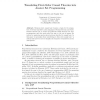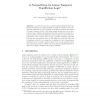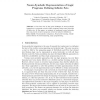3562 search results - page 55 / 713 » Introduction to Logic Programming |
103
click to vote
CORR
2011
Springer
14 years 4 months ago
2011
Springer
Nonmonotonic causal logic, introduced by Norman McCain and Hudson Turner, became a basis for the semantics of several expressive action languages. McCain’s embedding of definit...
IFIP
1998
Springer
15 years 2 months ago
1998
Springer
A new scheduling agent for existing CIM multi-agent system is being currently developed at the Technical University of Kosice. The basic idea is to create an agent based on Schedu...
101
click to vote
JELIA
2010
Springer
14 years 8 months ago
2010
Springer
Abstract. Nonmonotonic causal logic became a basis for the semantics of several expressive action languages. Norman McCain and Paolo Ferraris showed how to embed propositional caus...
101
click to vote
JELIA
2010
Springer
14 years 8 months ago
2010
Springer
In previous work, the so-called Temporal Equilibrium Logic (TEL) was introduced. This formalism provides an extension of the Answer Set semantics for logic programs to arbirary the...
100
click to vote
ICANN
2010
Springer
14 years 10 months ago
2010
Springer
It has been one of the great challenges of neuro-symbolic integration to represent recursive logic programs using neural networks of finite size. In this paper, we propose to imple...



